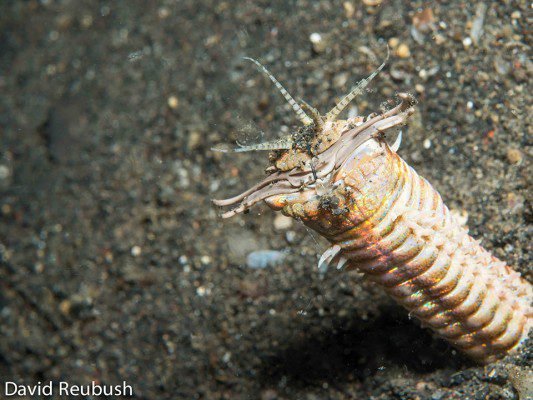
Let’s dive into the amazing world of Bobbit worms and explore the strategies they use to sense movement in their environment. This ability not only helps them find food but also lets them avoid becoming dinner themselves. So, grab a cup of coffee, and let’s uncover this marine mystery!
The Basics of Bobbit Worms
Bobbit worms, scientifically known as *Eunice aphroditois*, are marine polychaetes that call the sandy and muddy ocean floors home. These worms are often found in warm, tropical waters, and they can blend into their surroundings, making it easy to go unnoticed. Their bodies are made up of many segments, which gives them flexibility and strength. But it’s their predatory behavior that truly catches our attention.
What’s particularly interesting about Bobbit worms is their hunting technique. They lie buried in the substrate, with just their head poking out, waiting for unsuspecting prey to swim by. When something moves in the water column—like a fish or another tiny marine creature—they spring into action with lightning speed. But how do they know something is there? That’s where their remarkable sensory adaptations come into play.
How Do Bobbit Worms Sense Motion?
Bobbit worms have developed a set of sensory organs that help them detect vibrations and movements in the water. Particularly, they possess *mechanoreceptors*—specialized cells that respond to pressure changes and vibrations. These receptors are sensitive, allowing the worms to pick up even the faintest movements nearby.
Picture it this way: Imagine you’re at a quiet café, and you hear someone drop a spoon. Even if you can’t see them, that sound alerts your senses, right? Similarly, Bobbit worms can sense even the smallest disturbance in the water around them, triggering an instinctive hunting response. This ability is crucial for their survival, allowing them to capture prey efficiently.
The Role of Eyes and Other Sensory Organs
While Bobbit worms rely heavily on mechanoreceptors, they also have simple eyes. These eyes don’t function like ours, as they can’t see detailed images. Instead, they can detect light changes and movement. So, when a shadow passes over or a flash of light appears, it could mean potential prey is near.
Think of it this way: if you were playing hide-and-seek in a dark room, you wouldn’t need to see your friend clearly; you’d just need to notice any movements or changes in light. That’s similar to how Bobbit worms utilize their vision. They combine these visual cues with their other sensory inputs to make quick decisions in a dynamic environment.
Adaptations for Survival
Living on the ocean floor comes with its dangers. Bobbit worms face threats from larger predators, such as fish and other marine animals. Because of this, they’ve adapted some impressive survival techniques.
First off, their burrowing lifestyle allows them to remain hidden from most predators. They can quickly retract into their sandy or muddy homes if danger approaches. Additionally, their ability to detect motion gives them a substantial edge when it comes to spotting both prey and threats.
You might say they have the best of both worlds: they’re excellent hunters while simultaneously being adept at avoiding being hunted. This adaptability is a key reason why Bobbit worms have thrived in various marine environments for millions of years.
Why Motion Detection Matters
Understanding how Bobbit worms detect motion isn’t just fascinating; it also gives us insights into marine ecology and predator-prey dynamics. The ability of these worms to sense changes in their environment affects the overall balance of the ecosystems they inhabit.
For example, healthy populations of Bobbit worms can help control the abundance of smaller marine creatures. If these worms weren’t around, you might see an overpopulation of certain species, which could then lead to a ripple effect throughout the food chain. So, the way they detect motion plays a vital role not only in their survival but also in maintaining the ecological balance of their habitats.
Comparing Bobbit Worms to Other Marine Predators
When considering motion detection, it’s interesting to compare Bobbit worms with other marine predators. Take the common octopus, for instance. Octopuses use a combination of keen eyesight and sophisticated camouflage to hunt their prey. They’re known for their intelligence and problem-solving abilities, which is quite different from the simpler, instinct-driven tactics of Bobbit worms.
Yet, both creatures share that fundamental goal: survival. While Bobbit worms rely on passive hunting methods, octopuses actively seek out their food. This contrast highlights how different organisms have evolved unique adaptations to navigate their environments effectively.
Bobbit worms are a testament to the marvels of evolution and the intricate ways marine life has adapted to thrive. Their ability to detect motion in the water column not only aids in their hunting but also plays an essential role in the delicate balance of marine ecosystems. By blending patience with precision, Bobbit worms paint a picture of survival that captivates scientists and ocean enthusiasts alike.
So, the next time you think about these underwater ninjas, remember the fascinating mechanics behind their motion-detecting abilities. It’s a reminder of how even the simplest creatures can hold remarkable secrets in their natural habitats. Let this knowledge spark your curiosity to explore more about ocean life and the amazing adaptations within it!
